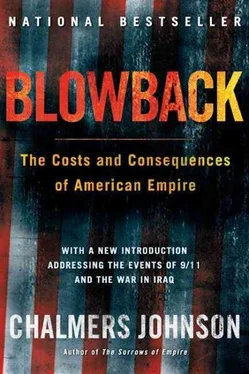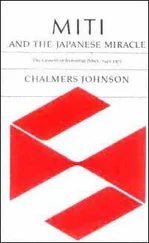Chalmers Johnson - Blowback, Second Edition - The Costs and Consequences of American Empire
Здесь есть возможность читать онлайн «Chalmers Johnson - Blowback, Second Edition - The Costs and Consequences of American Empire» весь текст электронной книги совершенно бесплатно (целиком полную версию без сокращений). В некоторых случаях можно слушать аудио, скачать через торрент в формате fb2 и присутствует краткое содержание. Год выпуска: 0101, ISBN: 0101, Издательство: Macmillan, Жанр: Старинная литература, на английском языке. Описание произведения, (предисловие) а так же отзывы посетителей доступны на портале библиотеки ЛибКат.
- Название:Blowback, Second Edition: The Costs and Consequences of American Empire
- Автор:
- Издательство:Macmillan
- Жанр:
- Год:0101
- ISBN:9780805075595
- Рейтинг книги:5 / 5. Голосов: 1
-
Избранное:Добавить в избранное
- Отзывы:
-
Ваша оценка:
- 100
- 1
- 2
- 3
- 4
- 5
Blowback, Second Edition: The Costs and Consequences of American Empire: краткое содержание, описание и аннотация
Предлагаем к чтению аннотацию, описание, краткое содержание или предисловие (зависит от того, что написал сам автор книги «Blowback, Second Edition: The Costs and Consequences of American Empire»). Если вы не нашли необходимую информацию о книге — напишите в комментариях, мы постараемся отыскать её.
Blowback, Second Edition: The Costs and Consequences of American Empire — читать онлайн бесплатно полную книгу (весь текст) целиком
Ниже представлен текст книги, разбитый по страницам. Система сохранения места последней прочитанной страницы, позволяет с удобством читать онлайн бесплатно книгу «Blowback, Second Edition: The Costs and Consequences of American Empire», без необходимости каждый раз заново искать на чём Вы остановились. Поставьте закладку, и сможете в любой момент перейти на страницу, на которой закончили чтение.
Интервал:
Закладка:
The second aspect of the ideological challenge to the Soviet Union was the development and propagation of an American economic ideology that might counter the promise of Marxism—what today we call “neoclassical economics,” which has gained an intellectual status in American economic activities and governmental affairs similar to that of Marxism-Leninism in the former USSR. Needless to say, Soviet citizens never understood Marxism-Leninism as an ideology until after it had collapsed, just as Americans like to think (or pretend) that their economics is a branch of science, not a fighting doctrine to defend and advance their interests against those of others. They may consider most economists to be untrustworthy witch doctors, but they regard the tenets of a laissez-faire economy—with its cutthroat competition, casino stock exchange, massive inequalities of wealth, and a minor, regulatory role for government—as self-evident truths.
Until the late 1950s, academic economics remained one of the social sciences, like anthropology, sociology, and political science—a non-experimental, often speculative investigation into the ways individuals, families, firms, markets, industries, and national economies behaved under different conditions and influences. It was concerned with full employment, price stability, growth, public finance, labor relations, and similar socioeconomic subjects. After it became the chief ideological counterweight to Marxism-Leninism during the Cold War, its practitioners tried to extract it from the social sciences and re-create it as a hard science.
Its propositions were now expressed less in words than in simultaneous equations, the old ideas of Adam Smith reappearing as fully mathematized axioms, increasingly divorced from empirical research. Its data were said to be “stylized facts,” and economists set out to demonstrate through deductive reasoning expressed in mathematical formulas that resources could be allocated efficiently only through an unfettered market. By now all these terms (“resources,” “efficiency,” “markets”) had been transformed into abstractions, not unlike the abstract formulations (“the proletariat,” “the bourgeoisie,” “class conflict”) of its Soviet opponents. English-speaking economics became such a “hard science” that in 1969 the central bank of Sweden started giving Nobel Prizes to its adepts, virtually all of them American academicians. This ensured that virtually all aspiring economists would in the future try to do so-called theoretical economics—that is, the algebraic modeling of markets—rather than old-fashioned empirical and inductive research into real-world economies.
Economics split from the social sciences and took up a new position somewhere close to mathematics. Economists were now endlessly called upon by governmental bodies to testify that the American economy was unmatchable, even if it sometimes behaved badly because of overspending liberals, pork-barrel politics, or greedy monopolists. Alternatives to it were understood to be either converging with it or destined to fail. Economics no longer studied the economy; it spoke ex cathedra about what was orthodox and what was heresy. Meanwhile, empirical research on economic phenomena migrated to business schools, commercial think tanks, and the other social sciences.
Unquestionably, after the first two decades of the Cold War, in a purely dichotomous choice between an economy based on Marxism-Leninism and one based on free-market capitalism—as exemplified by the economies of the Soviet Union and the United States—most people around the world would have chosen the free market. But in East Asia, at the height of the Sino-Soviet dispute and the American war in Vietnam, neither ideology was working out according to either superpower’s script. The Chinese were discrediting forever whatever attractiveness might have remained in the forced-draft economic achievements of the Soviet model. Through bungling, megalomania, and deep ideological confusion about what Marxism and the Soviet experience taught, the Chinese Communist Party managed to kill thirty million of its own citizens and then, in a paroxysm of mutual blame, came close to destroying its unmatchable cultural legacy in the so-called Cultural Revolution. Today this period is recognized—even in China—as a monumental disaster, but at the time many Americans, from idealistic leftist students to presidents and other political leaders, failing to understand what was happening, retained a sentimental attraction to Mao Zedong and Zhou Enlai, the mismanagers of the Chinese revolution.
The truly surprising development in East Asia, however, was that America’s “non-Communist” satellites, protectorates, and dependencies were starting to get rich and to compete with their superpower benefactor. All of this was camouflaged by the Cold War itself, so that the enrichment of East Asia occurred almost surreptitiously. The year-in, year-out record-breaking growth rates of such previously poor places as Japan, South Korea, and Taiwan were not precisely what American elites had expected, but they were explained away as nothing more than confirmations—even overconfirmations—of officially espoused free-market ideology and so were greeted with parental pride.
If the capitalist economies of East Asia were starting to perform better than the United States itself, this anomaly was usually attributed to mysterious Japanese or Asian cultural or even spiritual factors or to complacency on the part of American managers and workers. By the time the Western world awoke to what had actually happened, economic growth in East Asia was self-sustaining and unstoppable by external actions (although many Asians thought this was exactly what the United States was attempting when its policies toward the area led to the meltdown of 1997). The enrichment of East Asia under the cover of the Cold War was surely the most important, least analyzed development in world politics during the second half of the twentieth century. It remains to this day intellectually indigestible in the United States.
The fundamental problem is not simply that in the Cold War era Japan attained a $5 trillion economy—although that alone was an unexpected competitive challenge to American economic preeminence—but how it did so. It had found a third way between the socialist displacement of the market advocated by Soviet theorists and an uncritical reliance on the market advocated by American theorists. The Japanese had invented a different kind of capitalism—something no defender of the American empire could accept. It was therefore assumed either that the Japanese were cheating (and all that we needed to compete successfully against them was a “level playing field”) or that they must be headed for a collapse similar to the one that had overtaken the USSR.
In turning neo-classical economic theory into a fighting ideology, American ideologues encountered one element of capitalist thought that they could not express in abstract, seemingly “scientific” mathematical terms. This was the set of institutions through which competitive market relationships actually produce their benefits. Institutions are the concrete, more-or-less enduring relationships through which people work, save, invest, and earn a living—such things as stock exchanges, banks, labor unions, corporations, safety nets, families, inheritance rules, and tax systems. This is the realm of the legal, political, and social order, where many considerations that govern the economy other than efficiency contend for primacy. For economic theorists institutions are “black boxes,” entities that receive and transmit economic stimuli but are themselves unaffected by economic theory.
In attempting to forge a fully numerical, scientific-looking model of the capitalist economy for purposes of the Cold War, Western ideologues simply assumed that the institutions of modern capitalism must be those that existed in the United States in the late Eisenhower era. This meant that savings were typically moved from the saver to industry through a capital market (such as the New York Stock Exchange) rather than, for example, through the banking system. They assumed that industrial-labor conflicts were settled by interminable strikes, and not by, for example, offering some workers career job security; and they assumed that the whole purpose of an economy was to serve the short-term interests of consumers, instead of some overarching goal such as the wealth and power of the nation as a whole.
Читать дальшеИнтервал:
Закладка:
Похожие книги на «Blowback, Second Edition: The Costs and Consequences of American Empire»
Представляем Вашему вниманию похожие книги на «Blowback, Second Edition: The Costs and Consequences of American Empire» списком для выбора. Мы отобрали схожую по названию и смыслу литературу в надежде предоставить читателям больше вариантов отыскать новые, интересные, ещё непрочитанные произведения.
Обсуждение, отзывы о книге «Blowback, Second Edition: The Costs and Consequences of American Empire» и просто собственные мнения читателей. Оставьте ваши комментарии, напишите, что Вы думаете о произведении, его смысле или главных героях. Укажите что конкретно понравилось, а что нет, и почему Вы так считаете.










